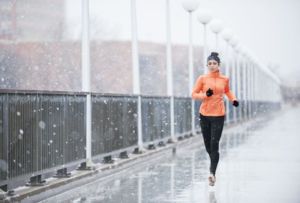Exercising Outside During Autumn
As the weather gets colder, it is the tendency of some people to move around less. Especially as the holidays and all associated festivities approach, many Americans lament the season as a time of lowered fitness and possible weight gain. Any health professional will readily advise that for optimum health, regular activity and exercise are vital throughout the year. If you find yourself less inclined to get out and exercise as we enter autumn, consider the following tips and activities to help you out.
Daylight Management
It is common knowledge that as the weather gets colder in this country, the sky gets darker sooner, making the days “shorter.” If you are reliant on an outdoor jog, particularly in the evening, you will want to reevaluate your route. If at any time you are traversing uneven or malleable ground, you may want to schedule so that you have ample sunlight, even if your trail has street lighting built-in. Also, if you think the earth is firm enough, make sure that the path is not obscured from general view from too long. We never want to believe the worst of our environment, but if you feel the increased darkness might encourage hostile actors, then plan accordingly. And if you are confident that your jogging route is sufficiently safe, but you still find yourself needing to exercise closer to the evening, you might look into reflective clothing that will make you readily visible to any oncoming motorists or fellow runners.
What to Wear In the Cold
Unless you are acclimated to that sort of thing, many people understandably experienced reduced function in cold weather. Indeed, the shorts and tank top that might have sufficed in the summer may no longer provide adequate comfort. If you find yourself getting excessively cold, you can naturally put on warmer or heavier clothing, but you may need to approach this with some caution. If you bundle up too much, you might create an excess of sweat, which can cool off very quickly and unduly lower your body temperature, which may lead to fatigue or sickness. The best way to approach this is to layer your workout clothes properly. Doing so will help keep you warm, mitigate too much moisture from getting on your skin, and help you better regulate your body temperature throughout your workout. The intensity of your activity and the duration of the session may determine the exact articles used, but the general rule you are going for is to have three layers: a base layer, a middle layer, and an outer layer.
The base layer is the one closest to your body and is ideally meant to wick moisture away from your skin. Nowadays, these layers have been designed to fit very closely to the body and are made up of any number of wicking material, including polypropylene, polyester, wool, silk, Thermax, and Thinsulate. You want to avoid cotton for this layer because it tends to retain moisture and will draw heat away from you as a result.
The middle layer is primarily for insulation. While you do not want it to be as snug as your base layer, you still want your middle and base layers to be in some contact with each other. Another benefit of a proper middle layer is that it will draw moisture away from your base layer toward your outer layer. Common materials for middle layers include wool, polyester, fleece, and down.
The outer layer is typically a type of coat that will block the wind while allowing moisture to escape from your body. Typical outer layers are shells made out of Gore-Tex or similar synthetic. You may also want to look into extra features such as zippers for the pit and ankle regions, and other ventilation options. You will want to strike a balance with your outer layer being tough enough to withstand incidental shock but being light enough not to burden you before your session is finished.
The last thing to consider is keeping your extremities warm as needed. Socks and gloves to cushion impact and block out the cold are reasonable enough, but studies have shown that of all your extremities, most heat tends to escape from the head. If you find conditions getting uncomfortably cold, you will want to prioritize a hat. Whatever you choose, make sure you can remove your hat and gloves and store them on your person as needed.
Talk to your Doctor
While most anyone can keep up with an exercise regimen throughout autumn with a bit of preparation, it is undeniably a different set of circumstances. If you find yourself feeling ill or uncomfortable with your autumn exercises, consider speaking with your doctor. They can offer advice on how best to approach your workout regimen and, if necessary, may suggest medication to help alleviate any allergies or ailments.
Another thing you might want to consider is consulting a chiropractor. As the weather gets colder, many people claim to experience increased back and joint pain. While it should be pointed out the medical community has not produced an established correlation between colder weather and joint pain, there is considerable anecdotal evidence supporting the idea. Between this and the increased restrictions your body may be feeling with having to dress for the autumn temperatures, you might find yourself experiencing tension and strain not present during the summer. A chiropractor can offer you further advice on how best to exercise throughout the season, and if you require it, may be able to perform an adjustment if your spine is misaligned at all.
It cannot be overstated how vital exercise is to our overall health. And yet there are compelling reasons why many people tend to ease up on the workouts going into autumn and especially through winter. However, if you are convinced of the benefits of exercising all year round and are committed to carrying a plan out, there are readily available means of doing so. Prepare to suit up and carry on.





